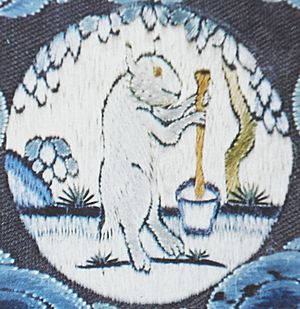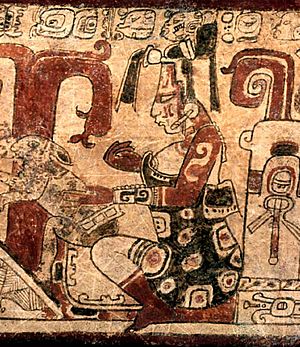Moon rabbit facts for kids
Quick facts for kids Moon rabbit |
|||||||||||
|---|---|---|---|---|---|---|---|---|---|---|---|

The image of a rabbit and mortar delineated on the Moon's surface
|
|||||||||||
| Chinese name | |||||||||||
| Chinese | 月兔 | ||||||||||
| Literal meaning | Moon rabbit/hare | ||||||||||
|
|||||||||||
| Alternative Chinese name | |||||||||||
| Chinese | 玉兔 | ||||||||||
| Literal meaning | Jade rabbit/hare | ||||||||||
|
|||||||||||
| Vietnamese name | |||||||||||
| Vietnamese alphabet | thỏ ngọc | ||||||||||
| Chữ Hán | 玉兔 | ||||||||||
| Korean name | |||||||||||
| Hangul | 달토끼 | ||||||||||
|
|||||||||||
| Japanese name | |||||||||||
| Kanji | 月の兎 | ||||||||||
|
|||||||||||
The Moon rabbit or Moon hare is a legendary figure from stories in East Asia and among some Native American cultures. People imagined seeing a rabbit or hare in the dark spots on the Moon.
In East Asia, the rabbit is often shown using a mortar and pestle to pound something. What it's making changes depending on the country. In Chinese folklore, the rabbit often helps the Moon goddess Chang'e. It pounds the elixir of life for her. Sometimes, it makes cakes or rice cakes, or even medicine for people.
In Japanese and Korean stories, the rabbit pounds ingredients for mochi or other types of rice cakes. In Vietnam, the Moon rabbit often appears with Hằng Nga and Chú Cuội. Like in China, the Vietnamese Moon rabbit also pounds the elixir of immortality.
Some Native American cultures also have stories about rabbits and the Moon.
Contents
The Moon Rabbit: A Legend
The idea of a rabbit on the Moon is very old. One of the earliest Chinese writings, called the Chu Ci, mentions a hare on the Moon. This book was written during the Han dynasty. It says that a hare and a toad are always pounding herbs on the Moon for the immortals.
At that time, rabbits had not yet come to China. So, the original image was actually a hare. Later, poets from the Tang Dynasty called the hare on the Moon the "Jade Hare" (玉兔) or "Gold Hare" (金兔). These names were often used instead of the word "Moon."
Asian Moon Rabbit Stories
A famous Buddhist story, called a Jataka tale, tells about a rabbit. In this story, a monkey, an otter, a jackal, and a rabbit decided to do good deeds. They wanted to practice charity on the day of the full moon.
An old man came to them, begging for food. The monkey found fruits, the otter caught fish, and the jackal found milk-curd. The rabbit only knew how to gather grass. So, it offered its own body as food. The rabbit bravely jumped into a fire the man had made.
But the rabbit was not burned. The old man then showed that he was actually Śakra, a powerful god. He was so touched by the rabbit's kindness. To honor the rabbit, he drew its picture on the Moon for everyone to see. People say the image on the Moon still looks smoky from the fire. Many believe this rabbit was a Bodhisattva, a wise and kind being.
A similar story is found in a Japanese collection called Konjaku Monogatarishū. In that version, the rabbit's friends are a fox and a monkey.
The Moon rabbit legend is very popular across Asia. You can find it in China, Japan, India, Korea, Sri Lanka, Cambodia, Thailand, Vietnam, and Myanmar.
This legend also led to many special festivals. These include the Mid-Autumn Festival in China, Tết Trung Thu in Vietnam, Tsukimi in Japan, and Chuseok in Korea. In Vietnamese stories, the Jade Rabbit on the Moon is often with the Moon Lady and Cuội. They sit under a magical banyan tree. During the holiday, they come down to Earth and give out lanterns, mooncakes, and gifts to children.
North American Moon Rabbit Stories
Just like in Asia, some Native American cultures in North and Central America also have Moon rabbit legends. These stories also came from seeing a rabbit shape on the Moon.
In ancient Maya art, the Moon Goddess is often shown holding a rabbit. Another god connected to the Moon also appears with a rabbit.
An Aztec legend tells about the god Quetzalcoatl. He was living on Earth as a human and became very hungry and tired. A rabbit offered itself as food to save his life. Quetzalcoatl was so moved by the rabbit's kind offer. He lifted the rabbit to the Moon, then brought it back to Earth. He told the rabbit, "Everyone will remember you. Your image is in the light, for all people and for all times."
Another Mesoamerican story is about the creation of the fifth sun. The humble god Nanahuatzin bravely sacrificed himself in fire to become the new sun. But the rich god Tecciztecatl was scared and hesitated. When he finally jumped into the fire, he became the Moon. Because Tecciztecatl was a bit cowardly, the other gods felt the Moon should not be as bright as the Sun. So, one god threw a rabbit at his face to make his light dimmer. Another version says Tecciztecatl was a rabbit when he sacrificed himself. His shadow then appeared on the Moon.
In Canada and the United States, the Cree people have a different story. A young rabbit wanted to ride the Moon. Only the crane was willing to take him. The trip stretched the crane's legs because the heavy rabbit held them tightly. That's why cranes have long legs today. When they reached the Moon, the rabbit touched the crane's head with a bleeding paw. This left the red mark that cranes still have. The legend says that on clear nights, you can still see Rabbit riding the Moon.
See also
- List of fictional rabbits and hares
- Lunar pareidolia
- Man in the Moon
- Rabbits and hares in art
- Rabbits in culture and literature
- Tecciztecatl
- Tu'er Ye
- Lunar mare




